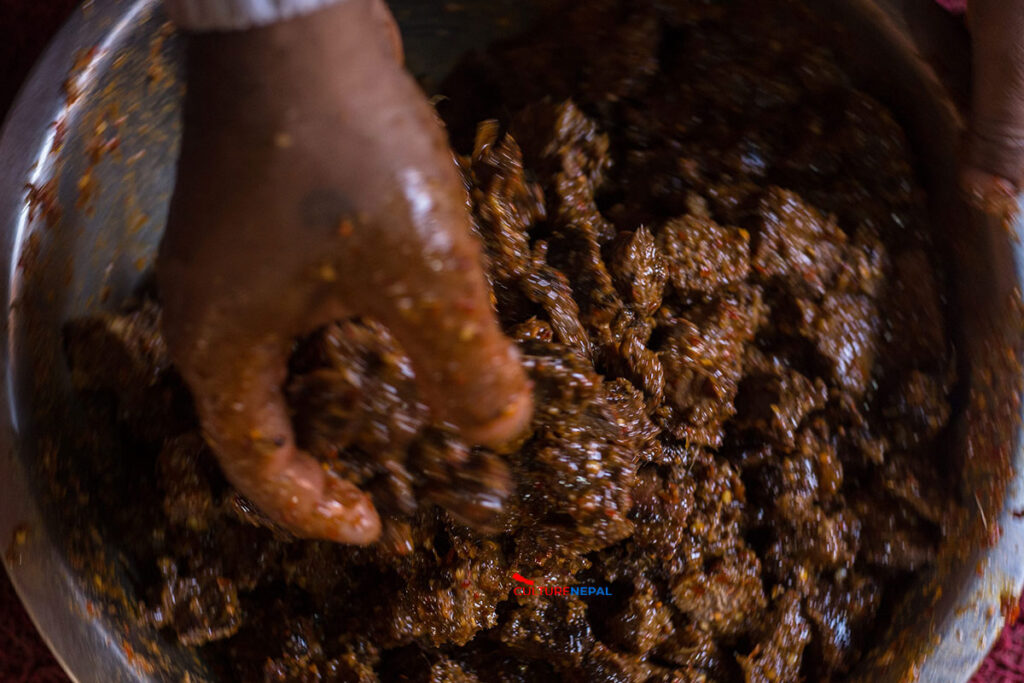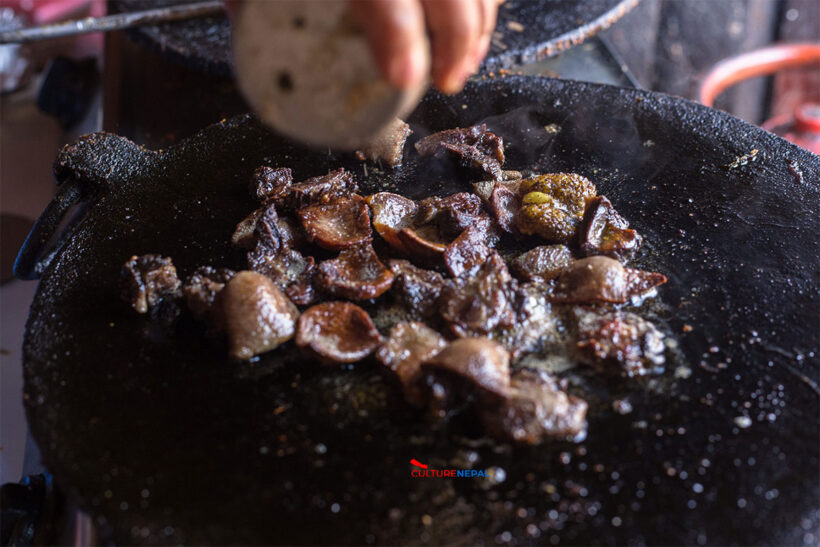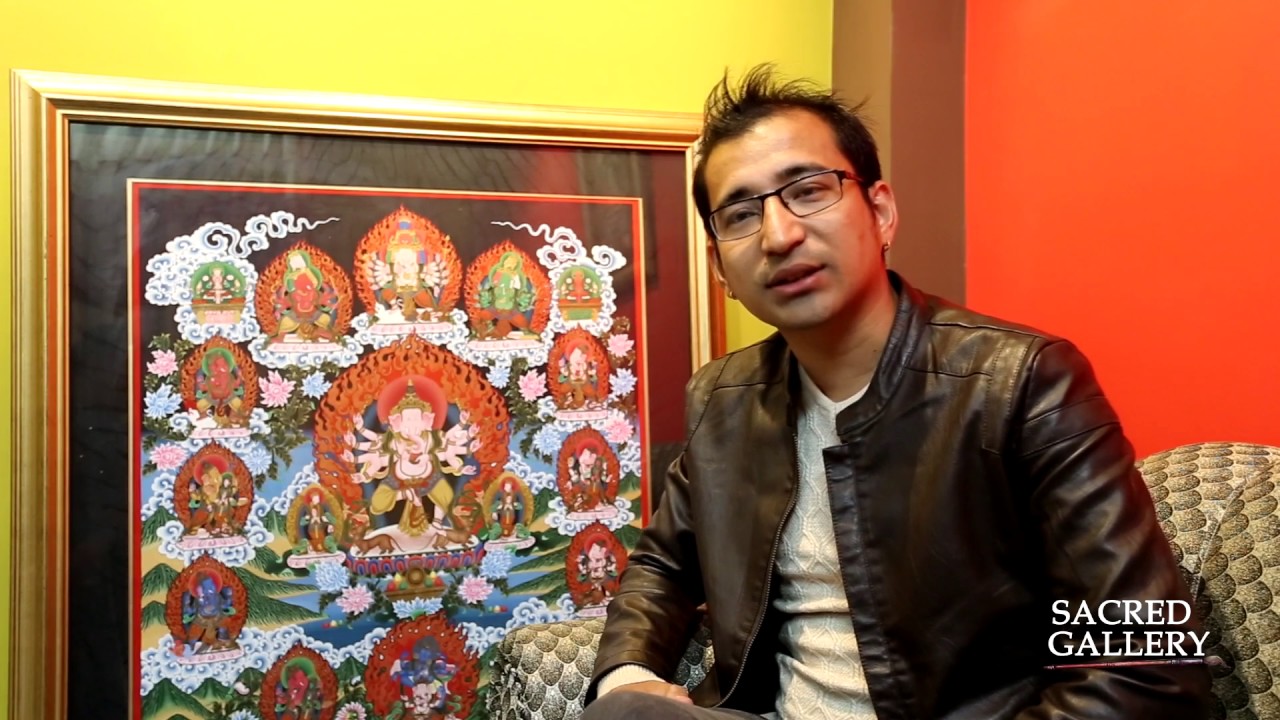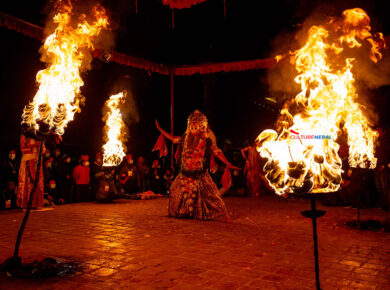The evening street food scene is so much better,” says Pawan, as we wind through the crowded lanes lined with fruit vendors. “That’s when people get off work, meet their friends for a drink and then go to the streets for a snack.”
It’s mid-afternoon at Lagankhel Bus Park in Patan and, although Pawan says this isn’t the ideal time to get Kathmandu’s best street food, the food carts and out-door stalls are swarmed with snacking customers. Be-hind one stall, a wok full of boiling oil is slowly browning triangular samosas. Across the lane, two girls laugh as they crouch on the cement with paper cones brimming full of freshly made Chatpatee and next to me, a woman eats sliced fruit generously sprinkled with salt and spices.
“Over there!” says Pawan, as he points to a geda gudi (pulses) cart, which offers a variety of toasted beans and corn kernels. “Let’s go try it.”
On a quest to understand street food culture in Kathmandu, I’ve commissioned 24-year-old Pawan Lama to take me on a day-long gastronomic adventure. Pawan, originally from Namo Buddha, has been working as a guide for six years and he considers himself an ex-pert on Nepali culture, heritage and food. Pawan and I would begin at Patan Durbar Square and slowly eat our way through the surrounding streets and alleys in an attempt to understand the fundamentals of street food in Nepal. We would start with no expectations, but with one mission try anything and everything edible we passed on the street.

Compared with other countries in Asia, like Thailand and Singapore, street food in Nepal is not yet as di-verse or sophisticated, for it is a relatively new market in the Kathmandu Valley. According to Pawan, Kathmandu’s street food culture started gaining steam only nine or ten years ago.
“Street food is still new here,” Pawan explains. “People watched movies and TV and learnt about street food culture from that. Then they copied it and started their own businesses.”
Street food and the vendors who sell it are often a re-flection of the unique ethnic makeup of a city as well as the regional influences that add interesting flavors to local cuisines. This becomes apparent after spending the day with street vendors in Kathmandu and it seems that the heaviest regional influence on Nepal’s street food scene comes from India.
“At first Nepali people felt shy to sell street food and to do this kind of business,” says Pawan. “Initially, the market was mostly dominated by Indians, but then Nepal’s started getting into the business too.” Pawan and I begin our food tour, walking slowly and deliberately with hawk eyes, looking and smelling for any-thing that we could taste. After less than 30 seconds, we come across a young woman named Sanju Tamrakar who is selling fried snacks. On newspaper-lined trays are stacks of samosas, aloo chop and jeri. According to Tamrakar, locals enjoy the fried sweets, which are mostly flour and sugar-based, for breakfast and during festivals like Father’s Day and Mother’s Day.

Tamrakar plucks out a coiled jeri from the stack and hands it to me. A jeri is made from a viscous dough of flour, ghee and water and sometimes saffron and cardamom for flavor. The semi liquid dough is packed into small plastic packets with holes to make circular, pretzel-like shapes into a vat of boiling oil until brown. The crisp coils are then soaked in a bowl of sugar syrup until fully saturated. Tamrakar’s jeri is perfectly crisp on the outside. It is sweet, but not overpoweringly so, as a small burst of syrup comes along with each bite.
“In Nepal we use these kinds of sweets for ceremonial purposes too,” Pawan explains adding,”Like when we have a ceremony for Lord Ganesh, we offer sweets be-cause Ganesh loves sweets.”
Pawan and I continue down the street and soon see a teenage boy doing a brisk business selling cold drinks. We stop and watch as the vendor, a somber 18-year-old named Buddha, expertly mixes lime sodas. Pawan says the drink is simply referred to as amilo,a salty and sour carbonated beverage that is a local favorite when the weather heats up.
Buddha grabs one of the clear glass bottles on his cart and pops the marble that seals the top. He, slices a lemon, squeezes the juice into the bottom of a tall glass and pours in the clear soda water. After a quick mix, he adds a spoonful of brown salt, which gives the beverage a distinctive sulphuric taste. Buddha says the sour and salty amilo is his most popular beverage, but he also sells sugary orange sodas for those with a sweet tooth.
“We learn a lot about street food from other places,” says Pawan, as we continue down the street. “People will move out of Nepal to other countries, then come back and bring a little bit of that culture here. They move around the world, copy the food and then come back here and adapt it.” Pawan and I are soon in the midst of the cacophony at the bus park: Vehicles chug by dropping off and, pick-ing up passengers, while the adolescent bus attend-ants lean out the open doors, screaming out the final destination soon their routes.
After a bus clears our path, a line of street carts comes into view selling the ubiquitous pani puri. ‘Pani’ means water in Nepali and ‘pull’ means roti or fried bread, which gives an accurate image of the crunchy snack; it is a spiced-water infused, hollow fried bread stuffed with potato.
Each pani purl cart is running a bustling business, but one in particular, owned by Shatrudhan Mahato from Motihari, India, is especially busy. Mahato dips his hand into a glass box full of the fried purl balls. He punches a hole in the top of the purl with his thumb, stuffs in a spoonful of aloo, or potato, and then dips the whole thing into a bucket of red-tinted water. The spiced water, or pani, is the key ingredient to the bite-sized snack with red chili powder, white salt, brown salt, lemon juice and masala spices for that unique flavor. Mahato transfers the stuffed and water-saturated ball onto a small metal plate and hands it to a customer, who places the entire pani purl into his mouth and finishes it in one bite.
One customer, Bishwas Rai, stands in front of the cart, stuffing himself until he’s full. Snackers are sure to leave satisfied, but without breaking the bank. The price of a half-plate of pani puri (three pieces) is five rupees and a full-plate. (six pieces) is ten rupees.”I eat street food at least once a day and it’s always pani puri,” Rai says, as his toddler daughter, who seems to have inherited Rai’s affinity for the snack, munches on a plain purl ball. Mahato, the cart owner, as well as many other street vendors we meet on our gastro-nomic journey come from India. Pawan says the high percentage of international street vendors generally exemplifies a broader mindset of many Indian immigrants in Nepal. “Many Indian people come to Nepal and want independent work,” explains Pawan. “They don’t want to work in factories or under anyone else, so they come here and start their own businesses. These businesses-are small, but they are their own.”
Next to Mahato’s pani purl stall, a slight, amicable woman named Nirmala Dahal stands behind a geda gudi cart. The cart, which is attached to a bicycle, is divided into sections that are brimming full of geda gudi (pulses) like roasted peanuts, toasted corn kernels, popcorn, soybeans, chana, kerau and bakula. The most popular item Dahal sells is surely the chatphate a snack mix of geda gudi, spices and puffed rice. On this food tour, I’ve noticed chatphate stalls everywhere; groups of school girls eating it while waiting for the bus, small children snacking on it under a tree and even businessmen enjoying it on their lunch break. Chatpate seems to be a local favorite so I’m eager to try the spiced mix for myself. Dahal begins by putting a scoop of puffed rice into a container and then adds soaked chickpeas, peanuts, soybeans and a packet of spiced and dried snack noodles. With a paring knife, she slices in one green chili, a boiled and skinned potato and one small raw onion. Then go in chili flakes, salt, masala spices, lemon juice, oil and a red “tomato sauce,”which is actually a homemade concoction of tomatoes, lopsi and lemon juice. Everything is mixed, poured into a paper cone and served with a small cardboard cutout of an old Surya cigarette pack, which is to be used as a scoop.
Dahal’s Chatpate is a perfect blend of spice and tan&. The texture is multilayered, with the crunchiness of the pea-nuts and soybeans balanced by the soft potatoes and on-ions. Pawan and I share the delectable mix, which costs 15 rupees, and talk with other customers. Barsha Tamang, a young woman wearing dark eye makeup, stands next to us, also eating a cone filled with Dahal’s Chatpatel love it because of the spicy and sour flavors,” Tamang says after eating a scoop. “But, my favorite street food depends on my mood on that day.”
Pawan and I continue to meander down the energetic lanes. We meet Maila, a surly man smoking a cigarette selling Shree Ganesh ice-cream from a rusty cart. In the midst of the smog of the bus park, a woman named Parvati Pandey waves us down to try her kulfi, which is a South Asian version of Maila’s plain ice-cream. The frozen, yellow kulfi is served on a toothpick and has a surprising spiced flavor. Pandey’s ingredients for her kulfi are milk, sugar, coconut, cashew nut and chokoda, the last two of which are found at ayurvedic shops in Kathmandu.
As we make our way around the bus park talking to every food vendor who will engage us, Nepal’s street food culture reveals itself as a flourishing market that is still gaining speed. The snacks available are not hugely diverse, but the people who offer them are. The vendors are from all over the region and each of them seems to bring their own unique spin on the food, often influenced by the places they call home. Around every turn and behind every bus is another cart or enterprising vendor selling food from a basket. There is a woman vending sliced fruit including pineapple, guava and watermelon topped with salt and red chili powder. Later I see a young girl dolling out piro kakro, large cucumber slices sprinkled with salt and spread with a green chili paste.
To finish off our street food tour we make our way to a paan seller. Paan, a mix of herbs, spices and candied fruit wrapped in a betel leaf can be had sweet or with tobacco and is often chewed after a meal as a digestive aid. I order one sweet paan and the Indian vendor expertly sprinkles, dabs and shakes in a smattering of ingredients. After to-day’s food adventures, which have plied my palate with sweet, salty, spicy, fresh and fried food, the wrapped leaf packet is a welcome end to the eating marathon.
As I slowly chew my paan. Pawan and I retrace our steps and ponder what’s in store for street food in Kathmandu. “I think the future of this business is good. It wasn’t so big a few years ago, but now it’s everywhere – Patan, Bhaktapur, Boudha, Swayambhunath…,” he says. “The food here is just so tasty, even if you eat it all the time, you’ll never get bored.”





